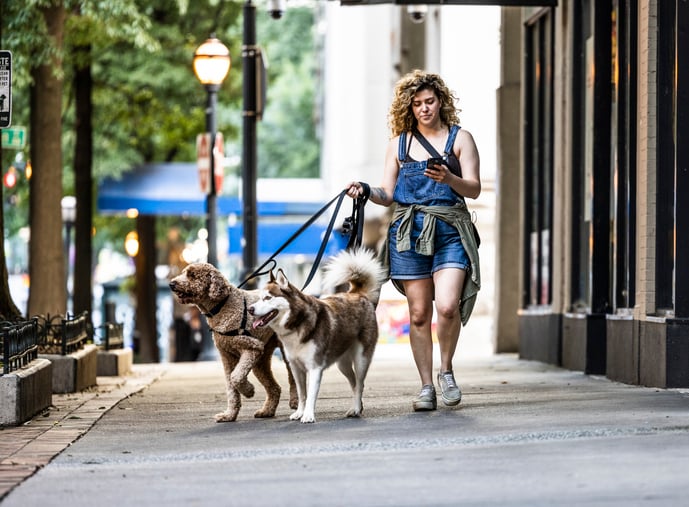In our increasingly busy world, professional dog walkers are the heroes who make sure our pups get their bathroom breaks and the essential outside time they need during the day. But dog walking isn’t all fun and games. It’s a serious business that requires lots of skill, know-how and more than a few very important rules. Before dog walkers and owners jump into a new pet care routine, it’s important to make sure you have a dog walking contract in place.
“Contracts help protect everyone involved,” says Ali Smith, a former dog walker, award-winning professional dog trainer and the founder of the dog care resource Rebarkable. “They set expectations and prevent disappointment. Successful relationships are all about creating proper boundaries, and a contract does that.”
Having a contract in place helps ensure safe and reliable care for beloved pets and protects the needs and interests of the dog walker as well. Here’s why you should consider drafting a dog walking contract, what you should include in it and how to make it happen.
What is a dog walking contract?
Dog walking seems like a pretty straightforward gig. So, why do you need a contract?
The main purpose of a contract is to outline expectations, says Melonie San Pietro, the owner of Wanderpups Dog Walking and Pet Sitting in Washington, D.C. For example, how will the dog walker get in and out of the client’s home securely? Is the walker insured in case of an accident? What happens if it snows?
All of this and more is outlined in a contract or service agreement to prevent headaches and confusion down the road. Contracts also help guarantee that clients’ rights and property will be protected and give business owners the ability to enforce policies to ensure their continued success.
“Verbal agreements aren’t sufficient,” adds Smith. “I’d suggest for new dog walkers, every client gets a contract, friends and family included.”
How do you write a dog walking contract?
A lot of dog walkers rely on apps to connect with clients and schedule their appointments. Sometimes, San Pietro says, these apps offer their own versions of contracts and client agreements. Dog walkers may also create their own custom documents using examples online.
Mary Kogut-Lowell, a business attorney and pet owner who has hired pet care providers for her own dogs, says the most important step is verifying that your contract is legally sound.
“Having a service agreement is always a good idea to reduce the risk of misunderstandings; however, an agreement will not be helpful if it is poorly drafted or incomplete,” she explains. “Agreements should always be reviewed by an attorney to ensure compliance with legal requirements.”
What should be included in a dog walking contract?
Here are some of the key items that should be included in a dog walking contract.
1. Job duties
A dog walking contract should outline the dog walker’s major responsibilities and the process for carrying those out. This includes:
- How often dog walking services will be provided.
- How long each walk will be.
- Where leashes and supplies will be located.
- Procedures for picking up and returning pets.
The contract is also the place to define and set boundaries regarding the scope of the dog walker’s job. For example, dog walkers can state that their services are limited to walking only. Or, if a dog walker agrees to additional jobs, like checking the mail or performing other small household tasks, those added duties can be outlined.
“Sometimes a dog walker will bring in packages or people can book a plant watering or light service if they’re out of town, and then they’ll just be charged extra for that,” San Pietro says.
2. Hours and schedules
Your contract should outline the dates and times when services will be provided. San Pietro says this should include a two to three-hour time window for walking services, rather than a specific time the dog walker will arrive.
“Every day is different for a dog walker and thousands of things can happen, between house keys not being left for the walker or dogs not wanting to go back home,” she explains. “If you’re walking, say, 10 dogs a day, you could have a delay with each of those dogs, and then that sets you back two hours.”
Setting a clear arrival window guarantees that services will be provided, but doesn’t set strict expectations that a dog walker may not be able to meet if they have unexpected delays.
Additionally, Smith says, the contract should include:
- Standard business hours.
- Policies for holidays and weekends.
- Sick day protocol.
- A cancellation policy.
“As dog walkers, we tend to be expected to be constantly available, and we can’t or we’ll never have a life,” she adds. “Putting those expectations in place straight away helps keep a work-life balance.”
3. Payment information
Smith and San Pietro say any dog walking contract should clearly outline all payment information, including:
- Standard rates.
- When payment is due.
- How to pay.
- Late fees and when they start accruing.
- Cancellation fees.
- Policies for additional charges.
This transparency allows clients to see exactly what they’re agreeing to pay and easily make their payments. It also helps dog walkers enforce their payment policies when needed.
“Sometimes you’ll get to a house and they’ll have moved the leash, so then you spend 30 minutes looking for it, and then you still need to walk the dog for 30 minutes,” San Pietro says. “That’s the dog walker’s time, so it’s important to be clear in the contract that they have to charge for that.”
4. House keys and security protocols
Because dog walkers often work when dog owners aren’t at home, key protocols and home security are major parts of the job. Both Smith and San Pietro say it’s vital for contracts to include a key release form or other documentation that lists:
- Any lock box, key or access code provided to the dog walker.
- How many keys dog walkers have access to.
- Which doors the keys work with.
- Who is responsible for replacing lost keys.
- Who else has access to the keys (nannies, gardeners, etc.), if applicable.
San Pietro says contracts should also specify whether owners will still be charged in the event that the dog walker can’t access the house for some reason, like a key doesn’t work or an alarm goes off.
“Lots of times clients cut brand new keys to put in the lock box for the dog walker, but they don’t test the keys, so then the keys don’t work. Or they might have a house guest that turns the alarm on,” she explains. “That’s not the fault of the company or dog walker, but it is the responsibility of the client, so it needs to be clear what happens in those situations.”
5. Behavioral expectations
Contracts should include clear rules regarding biting, aggression and other potential behavioral issues. This not only protects the walker, but also helps the dog owner know if their pet is ready for walking services.
“It’s a dog owner’s job to know whether their dog can handle a dog walker,” says San Pietro.
San Pietro’s contracts typically include a “one-bite rule” that states services will be terminated after the first time the dog walker is bitten. “It also says that if the dog walker gets to your house and your dog is showing extreme fearfulness, anxiousness or aggression, then that dog will not be walked,” she says.
In addition to outlining behavior rules, San Pietro says walkers should clearly state whether they provide training services. “A lot of people want us to enforce new training or help with socialization. But a dog walker makes, like, $20 an hour and trainers charge $150 an hour,” she says. “I’m very clear that if any requests even resemble training, I don’t do it.”
Some dog walkers, like Smith, may have a background in professional training and offer training walks as an additional service. Either way, the contract should clearly define what is and is not allowed.
6. Medical information
In her experience hiring and working with pet service providers, attorney Kogut-Lowell says she always ensures contracts include vital health information, like:
- Vaccination requirements.
- Emergency protocol.
- Spay/neuter requirements.
- Guidelines for medications, allergies or other conditions.
Smith recommends that standard contracts also include a veterinary release form. This authorizes the dog walker to transport the pet to a vet if needed, as well as provides authorization for a veterinarian to treat the pet and specifies who is responsible for the charges.
7. Licenses, certifications and insurance information
For the protection of both themselves and their clients, many dog walkers are professionally licensed, bonded and insured. San Pietro says this information should be included in the contract and specific policy details should be readily available.
Additionally, contracts should clearly state any requirements for pets to be tagged and microchipped, if required in your area.
8. Communication
Do you prefer text messages to phone calls? Is booking required through a specific platform? Smith says the contract is the place to nail those details down, for the convenience of both the client and the dog walker. For peace of mind, specify:
- Contact information.
- Preferred methods of communication.
- Booking procedures.
- The process for making changes to your agreement.
Remember that every important detail you include in your initial contract is one you don’t have to stress about later on. As Smith says, “All of these details will help create a simple, straightforward business process and streamline everything.”





